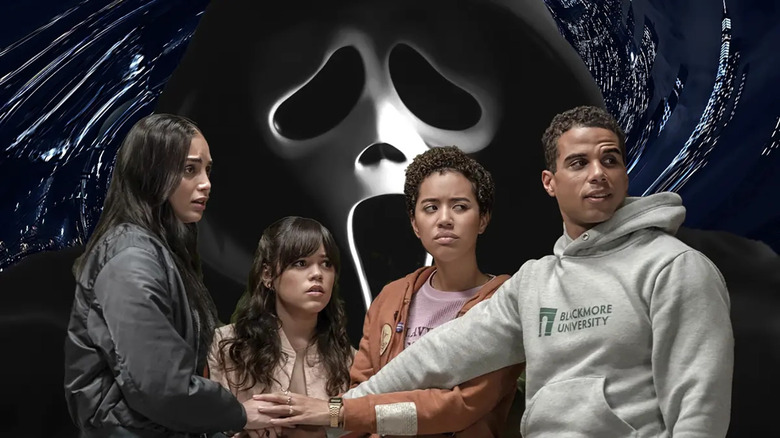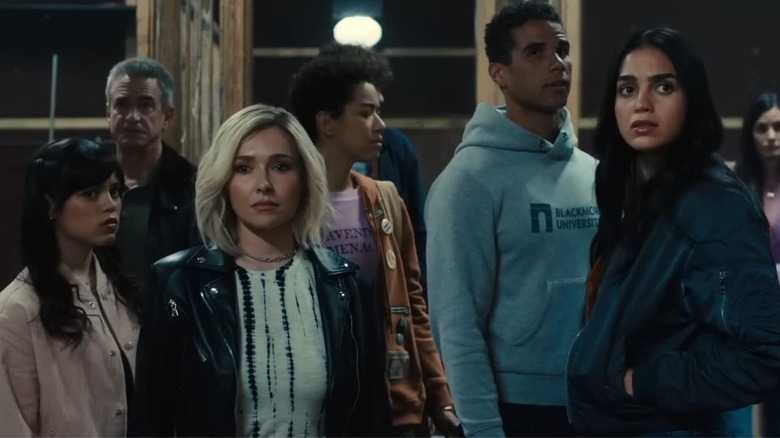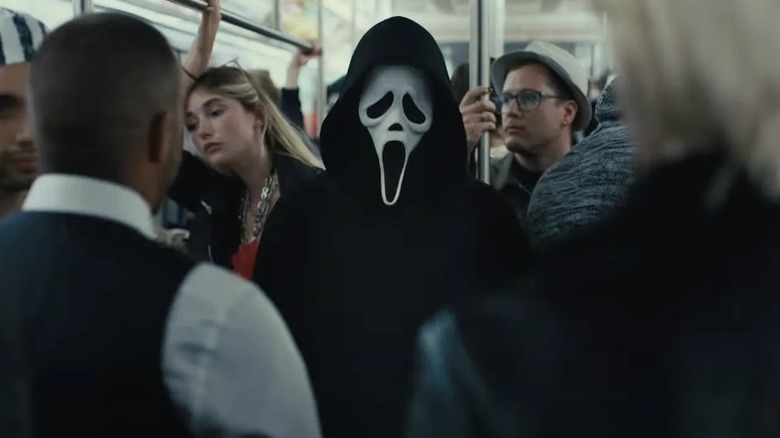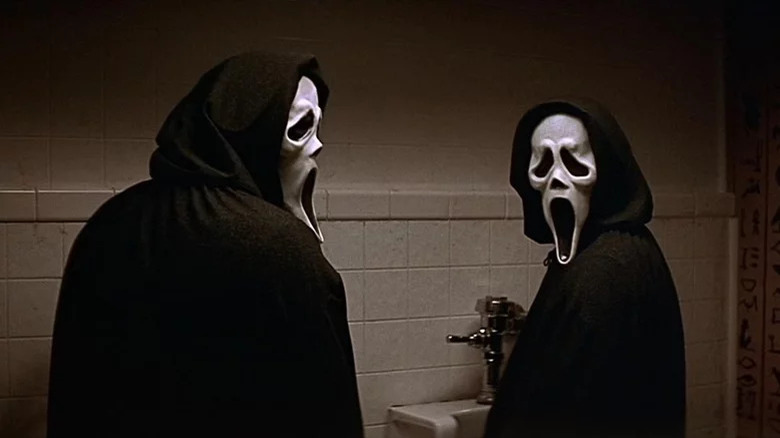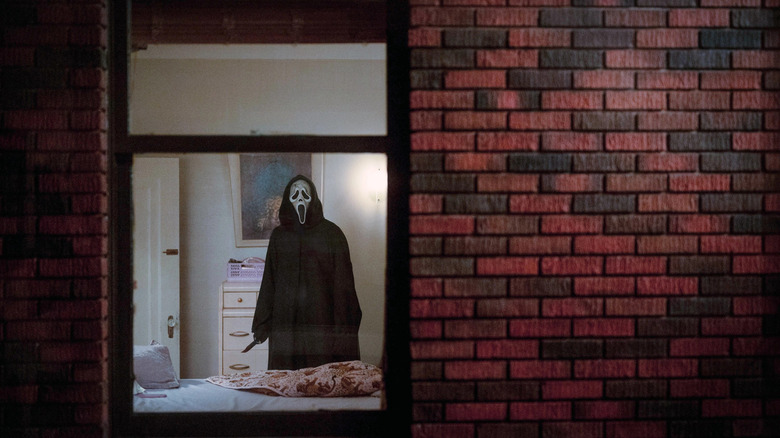Why Scream 6's Biggest Twist Is Also Its Weakest
This post contains major spoilers for all of "Scream VI."
For the first two-thirds of "Scream VI," the movie was on track to be the best of any of the sequels. Whereas previous "Scream" films have taken their time building up to a chaotic final half, this movie hits the ground running, giving us one suspenseful chase sequence after another. It helps that this movie doesn't need to spend much time introducing us to a whole new cast of characters like "Scream 4" and "Scream 5" had to do. We've already come to know Sam (Melissa Barrera), Tara (Jenna Ortega), Mindy (Jasmin Savoy Brown), and Chad (Mason Gooding), so we care when they're in danger far more than we did the first time around.
But though the movie's still a strong addition to the franchise overall, it made one major mistake in its final act: the killers are revealed to be Detective Bailey (Dermot Mulroney), Quinn (Liana Liberato), and Ethan (Jack Champion). For the first time in the series history, there are three Ghostfaces, not just two. Sounds like a cool way to up the stakes, right? Wrong. The three-killer reveal was probably the weakest part of the whole film and the main thing that keeps this movie from being one of the best horror sequels of all time.
To be fair to the twist...
The movie deserves some credit for setting the groundwork for the killers. Whereas Mickey's reveal in "Scream 2" seemed to come out of nowhere, no one can complain that "Scream 6" doesn't properly plant the idea in our heads that Ethan might be a killer. Both Mindy and Chad repeatedly accuse him of being one, after all, and his "I was studying" alibi is suspicious as hell.
Likewise, by the time Detective Bailey reveals himself, it's not a shocker either. When he tells Sam over the phone that Kirby (Hayden Panettiere) is almost certainly the killer, the fact that the movie doesn't immediately have Kirby confirm herself as such makes it clear that Bailey must've been lying. Not only that, but his repeated mentions of an unnamed dead son throughout the film definitely sets off alarm bells.
And then there's the fake-out death of Quinn. In hindsight, the fact that her death happens entirely off-screen should've been an obvious clue, not to mention the absurdity of her sitting on her bed without realizing Ghostface is right behind her, but somehow this one slipped past me. Nevertheless, the fake-out is earned and makes sense, just like the other two.
The problem is not with any of the killers individually, but with all of them together.
Bigger does always not mean better
A well-known trope at this point is the Inverse Ninja Law, or the Conservation of Ninjutsu, which basically means that if a protagonist has to face off against a single ninja, it'll be a difficult fight. If he has to face off against a hundred ninjas, the power of the individual ninjas will be diluted enough that the protagonist can still pull through. It's why in Netflix's "Daredevil," the hero spends what feels like a whole episode in season 1 fighting against a ninja, and then by season 2 he's fighting them off by the dozen. If any of those season 2 ninjas were as strong as that first one, Daredevil wouldn't stand a chance.
Well, the same rule applies to any other sort of villain, be it zombies, terminators, vampires, Daleks, and now Ghostfaces. The initial sense of upping the ante that comes from the three-killer reveal is immediately undermined by the inevitable realization that these killers aren't any more difficult to kill than the ones before them. In the last film, Richie and Amber revealed themselves with Sam, Tara, Gale, and Sidney all still alive and in fighting position, and they still held their own better than Bailey, Quinn, and Ethan do here. These three get absolutely destroyed, despite only having Sam and Tara left to deal with.
Despite how powerful Ghostface seemed in the first two-thirds of the film, these are physically the weakest post-reveal killers we've ever had. It's hard to blame the movie too much because this is an inevitable downside to bringing three killers into the film, but that's why they should never have gone with three killers in the first place.
Competing for screentime
But the biggest issue with three killers is not the way it makes each individual killer a little less threatening. No, the main problem is that it makes it so much harder for each character to make an impression. There's a reason why Jill from "Scream 4" so often makes it high up on the list of best Ghostfaces: she kills off her partner early, so all the focus in the final act gets to be on her. The movie gives her the space to deliver almost eight minutes straight of a (mostly uninterrupted) monologue, one that gives us a full, vivid idea of what type of person Jill actually is.
Meanwhile, the climactic killer monologue in "Scream VI" is split up between Ethan, Quinn, and Bailey, which means the three characters all kind of blend together. Ethan and Quinn feel particularly interchangeable, to the point where I can't imagine anyone in the world picking one of them as their favorite Ghostface. I previously thought Jack Quaid and Mikey Madison both struggled to make a proper impression with their post-reveal performances in "Scream 5," but that's nothing compared to how much Jack Champion and Liana Liberato were wasted here. They both make the most of the lines they get, but the movie simply doesn't have the time to give either of them the focus they deserve. As a result, two of the three killers in this movie feel like total afterthoughts.
Still an understandable choice
Maybe that's what the movie's going for: we're probably supposed to see Quinn and Ethan as interchangeable. They're just Bailey's thoughtless, cartoonish kids/minions. They exist primarily so Sam and Tara can each get their own badass kills in before it's time for them to team up on Bailey at the end. The idea of a whole family of killers is also honestly interesting, and it retroactively makes Richie's actions in "Scream 5" seem a little more realistic. (If this is Richie's family, no wonder he turned out so bad.)
But for everything the three-killer reveal gives us, I don't think it was worth it. The two-killer pattern was already pushing things, but now that we know three killers are always on the table from this point forward, it basically makes it impossible for viewers to figure future mysteries out. "Scream VI" veers too far into screw-the-audience territory, and leaves the door wide open for the next movie to have four killers, or five. More than anything, it seems to fall into the familiar franchise trap of constantly trying to raise the stakes at the expense of everything else. Instead of making things feel bigger and scarier, here this strategy ends up doing the opposite.
Although the three-killer twist doesn't ruin the series or anything, it may have put a bit of a dent in it. "Scream VI" is still a strong, commendable entry into the series, but hopefully they stick to two killers max from this point forward.
